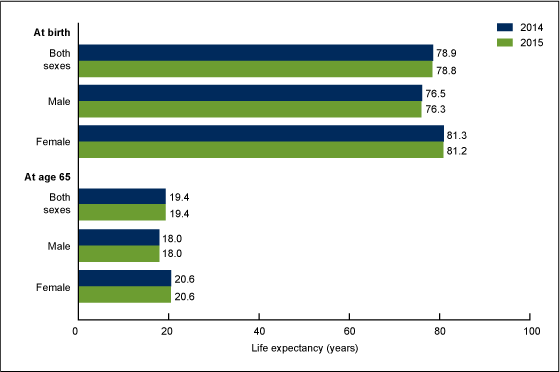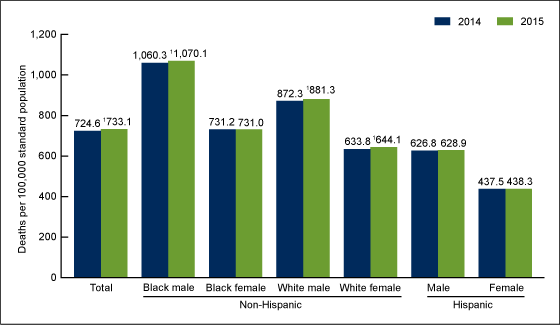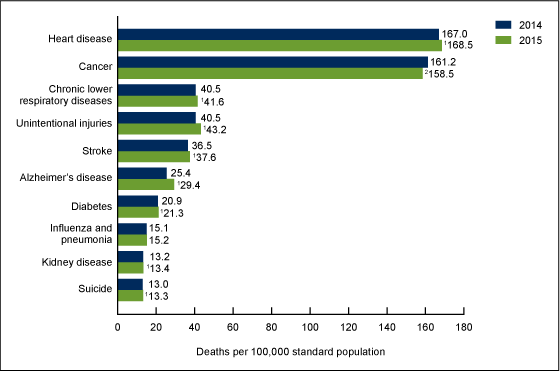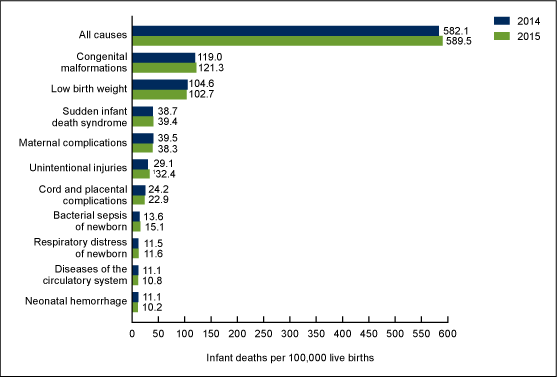Mortality in the United States, 2015
NCHS Data Brief No. 267, December 2016
PDF Version (375 KB)
Jiaquan Xu, M.D., Sherry L. Murphy, B.S., Kenneth D. Kochanek, M.A., and Elizabeth Arias, Ph.D.
Key findings
Data from the National Vital Statistics System, Mortality
- Life expectancy for the U.S. population in 2015 was 78.8 years, a decrease of 0.1 year from 2014.
- The age-adjusted death rate increased 1.2% from 724.6 deaths per 100,000 standard population in 2014 to 733.1 in 2015.
- The 10 leading causes of death in 2015 remained the same as in 2014. Age-adjusted death rates increased for eight leading causes and decreased for one.
- The infant mortality rate of 589.5 infant deaths per 100,000 live births in 2015 was not significantly different from the 2014 rate.
- The 10 leading causes of infant death in 2015 remained the same as in 2014, although two causes exchanged ranks.
This report presents 2015 U.S. final mortality data on deaths and death rates by demographic and medical characteristics. These data provide information on mortality patterns among U.S. residents by variables such as sex, race and ethnicity, and cause of death. Life expectancy estimates, age-adjusted death rates by race and ethnicity and sex, 10 leading causes of death, and 10 leading causes of infant death were analyzed by comparing 2015 and 2014 final data (1).
Keywords: life expectancy, leading cause, National Vital Statistics System
How long can we expect to live?
In 2015, life expectancy at birth was 78.8 years for the total U.S. population—a decrease of 0.1 year from 78.9 years in 2014 (Figure 1). For males, life expectancy changed from 76.5 years in 2014 to 76.3 years in 2015—a decrease of 0.2 years, and for females, life expectancy decreased 0.1 year from 81.3 years in 2014 to 81.2 years in 2015.
Life expectancy for females was consistently higher than it was for males. In 2015, the difference in life expectancy between females and males increased 0.1 year from 4.8 years in 2014 to 4.9 years in 2015.
In 2015, life expectancy at age 65 for the total population was 19.4 years, the same as in 2014. Life expectancy at age 65 was 20.6 years for females and 18.0 years for males, both unchanged from 2014. The difference in life expectancy at age 65 between females and males remained at 2.6 years in 2015.
Figure 1. Life expectancy at selected ages, by sex: United States, 2014 and 2015
NOTES: Life expectancies for 2014 were revised using updated Medicare data; therefore, figures may differ from those previously published.
Access data table for Figure 1.
SOURCE: NCHS, National Vital Statistics System, Mortality.
What are the age-adjusted death rates for race-ethnicity-sex groups?
The age-adjusted death rate for the total population increased 1.2% from 724.6 per 100,000 standard population in 2014 to 733.1 in 2015 (Figure 2). Age-adjusted death rates increased in 2015 from 2014 for non-Hispanic black males (0.9%), non-Hispanic white males (1.0%), and non-Hispanic white females (1.6%). Rates did not change significantly for non-Hispanic black females, Hispanic males, and Hispanic females from 2014 to 2015.
Figure 2. Age-adjusted death rates for selected populations: United States, 2014 and 2015
1Statistically significant increase in age-adjusted death rate from 2014 to 2015 (p < 0.05).
NOTE: Access data table for Figure 2.
SOURCE: NCHS, National Vital Statistics System, Mortality.
What are the leading causes of death?
In 2015, the 10 leading causes of death (heart disease, cancer, chronic lower respiratory diseases, unintentional injuries, stroke, Alzheimer’s disease, diabetes, influenza and pneumonia, kidney disease, and suicide) remained the same as in 2014 (Figure 3). The 10 leading causes accounted for 74.2% of all deaths in the United States in 2015.
From 2014 to 2015, age-adjusted death rates increased for 8 of 10 leading causes of death and decreased for 1. The rate increased 0.9% for heart disease, 2.7% for chronic lower respiratory diseases, 6.7% for unintentional injuries, 3.0% for stroke, 15.7% for Alzheimer’s disease, 1.9% for diabetes, 1.5% for kidney disease, and 2.3% for suicide. The rate decreased by 1.7% for cancer. The rate for influenza and pneumonia did not change significantly.
Figure 3. Age-adjusted death rates for the 10 leading causes of death in 2015: United States, 2014 and 2015
1Statistically significant increase in age-adjusted death rate from 2014 to 2015 (p < 0.05).
2Statistically significant decrease in age-adjusted death rate from 2014 to 2015 (p < 0.05).
NOTES: A total of 2,712,630 resident deaths were registered in the United States in 2015. The 10 leading causes accounted for 74.2% of all deaths in the United States in 2015. Causes of death are ranked according to number of deaths. Access data table for Figure 3.
SOURCE: NCHS, National Vital Statistics System, Mortality.
What are the leading causes of infant death?
The infant mortality rate (IMR)—the ratio of infant deaths to live births in a given year—is generally regarded as a good indicator of the overall health of a population. The IMR changed from 582.1 infant deaths per 100,000 live births in 2014 to 589.5 in 2015, but this change was not statistically significant.
The 10 leading causes of infant death in 2015 accounted for 68.6% of all infant deaths in the United States. The leading causes remained the same as in 2014, although two causes exchanged ranks (Figure 4). The IMR for unintentional injuries increased 11.3% from 29.1 infant deaths per 100,000 live births in 2014 to 32.4 in 2015. Mortality rates for other leading causes of infant death did not change significantly.
Figure 4. Infant mortality rates for all causes and the 10 leading causes of infant death in 2015: United States, 2014 and 2015
1Statistically significant increase in mortality rate from 2014 to 2015 (p < 0.05).
NOTES: A total of 23,455 deaths occurred in children under age 1 year in the United States in 2015, with an infant mortality rate of 589.5 infant deaths per 100,000 live births. The 10 leading causes of infant death in 2015 accounted for 68.6% of all infant deaths in the United States. Causes of death are ranked according to number of deaths. Access data table for Figure 4.
SOURCE: NCHS, National Vital Statistics System, Mortality.
Summary
In 2015, a total of 2,712,630 resident deaths were registered in the United States—86,212 more deaths than in 2014. From 2014 to 2015, the age-adjusted death rate for the total population increased 1.2%, and life expectancy at birth decreased 0.1 year. The age-adjusted death rate increased for non-Hispanic white males, non-Hispanic white females, and non-Hispanic black males. The rate for the total population rose significantly for the first time since 1999 (1).
The 10 leading causes of death in 2015 remained the same as in 2014. Age-adjusted death rates increased for eight leading causes. The only decrease in age-adjusted death rates among the 10 leading causes of death was for cancer. Life expectancy at birth decreased 0.1 year from 78.9 years in 2014 to 78.8 in 2015, largely because of increases in mortality from heart disease, chronic lower respiratory diseases, unintentional injuries, stroke, Alzheimer’s disease, diabetes, kidney disease, and suicide.
In 2015, a total of 23,455 deaths occurred in children under 1 year, which was 240 more infant deaths than in 2014. The leading causes of infant death were the same in 2015 as in 2014, although maternal complications, the third leading cause of infant death in 2014, became the fourth leading cause in 2015, while Sudden infant death syndrome, the fourth leading cause of infant death in 2014, became the third leading cause in 2015. The only significant change among the 10 leading causes of infant death was an 11.3% increase in the IMR for unintentional injuries.
Definitions
Cause-of-death: Based on medical information—including injury diagnoses and external causes of injury—that is entered on death certificates filed in the United States. This information is classified and coded in accordance with the International Statistical Classification of Diseases and Related Health Problems, Tenth Revision (ICD-10) (2).
Death rates: For 2015, based on population estimates for July 1, 2015, that are consistent with the April 1, 2010, census. These population estimates (as well as population figures for the 2010 census) are available on the National Center for Health Statistics’ (NCHS) website (3). Age-adjusted death rates are useful when comparing different populations because they remove the potential bias that can occur when the populations being compared have different age structures. NCHS uses the direct method of standardization; see Technical Notes of “Deaths: Final Data for 2014” (1) for more discussion.
Life expectancy: The expected average number of years of life remaining at a given age. It is denoted by ex , which means the average number of subsequent years of life for someone now aged x. Life expectancy estimates for 2015 are based on a methodology first implemented with 2008 final mortality data (4). Life expectancies for 2014 were revised using updated Medicare data; therefore, figures may differ from those previously published (5).
Leading causes of death: Ranked according to the number of deaths assigned to rankable causes (6).
Infant mortality rate (IMR): Computed by dividing the number of infant deaths in a calendar year by the number of live births registered for that same time period. IMR is the most widely used index for measuring the risk of dying during the first year of life.
Data source and methods
The data shown in this report reflect information collected by NCHS for 2014 and 2015 from death certificates filed in all 50 states and the District of Columbia and compiled into national data known as the National Vital Statistics System. Death rates shown in this report are calculated based on postcensal population estimates as of July 1, 2014, and July 1, 2015, which are consistent with the April 1, 2010, census. Differences between death rates were evaluated using a two-tailed z test.
About the authors
Jiaquan Xu, Sherry L. Murphy, Kenneth D. Kochanek, and Elizabeth Arias are with the National Center for Health Statistics, Division of Vital Statistics.
References
- Kochanek KD, Murphy SL, Xu JQ, Tejada-Vera B. Deaths: Final data for 2014. National vital statistics reports; vol 65 no 4. Hyattsville, MD: National Center for Health Statistics. 2016.
- WHO. International statistical classification of diseases and related health problems, tenth revision (ICD–10). 2008 ed. Geneva, Switzerland. 2009.
- National Center for Health Statistics. U.S. census populations with bridged-race categories.
- Arias E. United States life tables, 2008. National vital statistics reports; vol 61 no 3. Hyattsville, MD: National Center for Health Statistics. 2012.
- Arias E. United States life tables, 2014. National vital statistics reports. Hyattsville, MD: National Center for Health Statistics [Forthcoming].
- Heron M. Deaths: Leading causes for 2014. National vital statistics reports; vol 65 no 5. Hyattsville, MD: National Center for Health Statistics. 2016.
Suggested citation
Xu JQ, Murphy SL, Kochanek KD, Arias E. Mortality in the United States, 2015. NCHS data brief, no 267. Hyattsville, MD: National Center for Health Statistics. 2016.
Copyright information
All material appearing in this report is in the public domain and may be reproduced or copied without permission; citation as to source, however, is appreciated.
National Center for Health Statistics
Charles J. Rothwell, M.S., M.B.A., Director
Jennifer H. Madans, Ph.D., Associate Director for Science
Division of Vital Statistics
Delton Atkinson, M.P.H., M.P.H., P.M.P., Director
Hanyu Ni, Ph.D., M.P.H., Associate Director for Science



